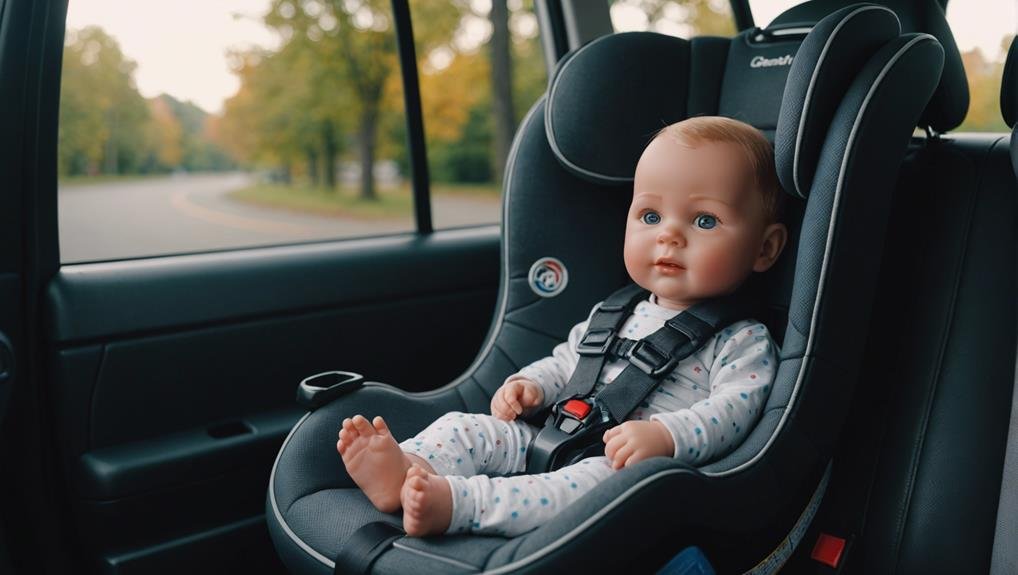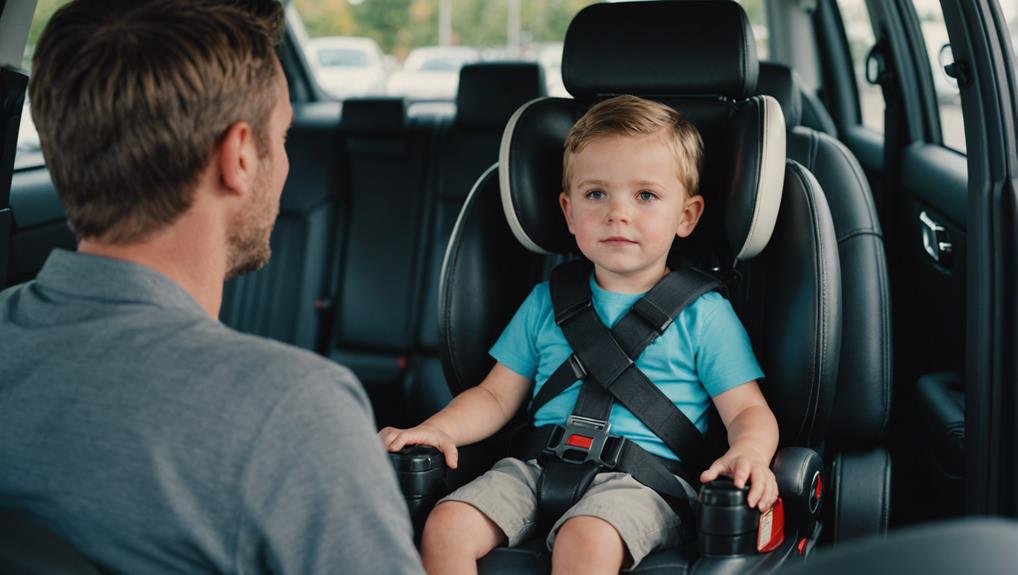"Cherishing Little Steps - A Haven for Baby and Family Journeys"
Car Seat
Imagine a car seat as a protective shield, surrounding your child in a cocoon of safety as you navigate the roads. Ensuring that this shield is in top condition and properly utilized can make all the difference in a potential accident. But did you know that there are common misconceptions about car seat safety that could put your child at risk? Understanding the intricacies of car seat regulations and best practices is crucial in safeguarding your little one during every car journey.
Importance of Car Seats

Car seats are crucial for ensuring the safety of passengers, particularly young children, in motor vehicles. Adhering to car seat regulations is vital to protect your child in case of an accident. Regulations often include guidelines on the appropriate type of car seat based on your child's age, weight, and height. It's essential to follow these regulations to ensure maximum safety.
Moreover, understanding car seat expiration dates is equally important. Over time, the materials in a car seat can degrade, reducing its ability to protect your child effectively. Manufacturers provide expiration dates based on the lifespan of the seat's components. Using an expired car seat can put your child at risk during a collision.
Therefore, regularly checking the expiration date and replacing the car seat when necessary is crucial for maintaining optimal safety standards for your young passengers.
Types of Car Seats
Understanding the different types of car seats is fundamental in choosing the appropriate one for your child's age, weight, and height to ensure their safety while traveling in a vehicle. When selecting a car seat, it's crucial to consider car seat regulations to guarantee compliance with safety standards.
There are various types of car seats available, including infant car seats, convertible car seats, booster seats, and all-in-one car seats. Infant car seats are designed for newborns up to around 2 years old, providing a rear-facing option for optimal safety. Convertible car seats can be used in both rear-facing and forward-facing positions, accommodating children as they grow.
Booster seats are suitable for older children who've outgrown their forward-facing seats, helping position the seatbelt correctly on the child's body. All-in-one car seats combine the features of infant, convertible, and booster seats, offering a long-term solution for your child's safety needs.
When evaluating car seats, also consider car seat comfort to ensure that your child remains secure and content during car rides. The comfort level of the seat can impact how well your child tolerates longer journeys, making it an essential factor to assess alongside safety features.
Rear-Facing Car Seats

When selecting a rear-facing car seat, prioritize your child's safety by ensuring it meets the appropriate age, weight, and height requirements.
Rear-facing car seats are crucial for infants and young children due to their ability to provide optimal protection in the event of a crash. Extended use of rear-facing car seats is recommended by safety experts as it significantly reduces the risk of injury in young children.
When considering rear-facing car seats, pay close attention to weight limits to ensure your child is within the safe range for the seat. Exceeding weight limits can compromise the effectiveness of the car seat in protecting your child in a collision. It's essential to follow manufacturer guidelines regarding weight limits to guarantee maximum safety.
Regularly check your child's weight to ensure they remain within the specified range for the rear-facing car seat.
Forward-Facing Car Seats
Ensure your child meets the age, weight, and height requirements when selecting a forward-facing car seat to prioritize their safety on the road. Child development plays a crucial role in determining when to transition from a rear-facing to a forward-facing car seat. Generally, children around the age of two, who've outgrown the rear-facing seat based on height and weight limits, are ready for a forward-facing option.
When choosing a forward-facing car seat, consider the vehicle's compatibility. Some car models may have specific requirements or limitations that impact the installation and effectiveness of the seat. Make sure the car seat fits securely in your vehicle and that the seat belt or LATCH system can be properly fastened.
Additionally, take into account your child's growth trajectory. Ensure that the headrest and harness height can be adjusted to accommodate your child's height as they continue to grow. It's essential to regularly check and adjust the seat to ensure a snug and secure fit as your child progresses through different stages of development.
Booster Seats

Consider the age, weight, and height requirements as you move from forward-facing car seats to booster seats to ensure your child's safety remains a top priority during your travels.
Booster seats are designed for children who've outgrown their forward-facing car seats but aren't yet tall enough to use the vehicle's seat belt properly. When transitioning to a booster seat, make sure your child meets the minimum height and weight recommendations provided by the manufacturer to guarantee optimal protection in case of a collision.
One crucial aspect to consider when using a booster seat is the proper positioning of the vehicle's seat belt. The seat belt should fit snugly across your child's chest, resting on the shoulder and not the neck, and low on the hips, touching the top of the thighs. This ensures that in the event of a crash, the force is distributed evenly across the strongest parts of the body, reducing the risk of injury.
Additionally, ensure that the booster seat you choose is compatible with your vehicle. Different vehicles have varying seat designs, and it's essential to select a booster seat that fits securely and correctly in your car to provide maximum protection for your child. Always refer to the booster seat manual and your vehicle's manual to confirm compatibility and installation instructions.
All-in-One Car Seats
An All-in-One car seat integrates multiple stages of a child's car seat needs into a single unit. These seats are designed to accommodate infants, toddlers, and older children by offering convertible options that can be adjusted as your child grows.
One key feature of All-in-One car seats is the extended rear-facing capability, which provides enhanced safety for young children. This extended rear-facing option allows children to remain facing the rear of the vehicle for a longer period, which is recommended by safety experts.
With All-in-One car seats, parents can transition from rear-facing to forward-facing and eventually to booster mode without needing to purchase separate seats for each stage. This not only provides convenience but also ensures that your child is properly restrained at every developmental stage.
When choosing an All-in-One car seat, consider factors such as weight limits, height adjustments, and ease of installation to guarantee the utmost safety for your little one.
Safety Features to Look For

Look for side-impact protection, energy-absorbing foam, and a secure harness system when evaluating the safety features of an All-in-One car seat. Side-impact protection is crucial as it shields your child from potential collisions from the side.
The energy-absorbing foam inside the seat is designed to absorb and distribute crash forces, reducing the impact on your child. When examining the harness system, ensure it's easy to adjust and fits snugly around your child. Opt for harness straps that are adjustable and have multiple height positions to accommodate your growing child.
Before making a purchase, check if the car seat has undergone rigorous crash tests to meet safety standards. These tests simulate real-life accident scenarios to assess how well the seat protects your child.
When inspecting the harness straps, ensure they aren't twisted or frayed, as this can compromise their effectiveness in securing your child during a crash. By prioritizing these safety features, you can provide your child with optimal protection while on the road.
Proper Car Seat Installation
To ensure the proper installation of your car seat, it's important to follow manufacturer instructions meticulously and use the appropriate installation method for your specific seat model. Failure to do so could compromise the safety of your child in the event of a crash.
Familiarize yourself with local car seat laws as they may dictate specific guidelines for installation. When installing your car seat, ensure it's tightly secured in the vehicle. You shouldn't be able to move the seat more than an inch in any direction. Additionally, be mindful of the weight limits specified by the manufacturer. Exceeding these limits could lead to the car seat failing in the event of an accident.
Remember to check the expiration date of your car seat. Over time, the materials can degrade, impacting the seat's effectiveness in a crash. Regularly inspect the seat for any signs of wear and tear, and replace it if necessary.
Following these installation tips and guidelines will help keep your child safe and secure while traveling.
Common Car Seat Mistakes
Making common mistakes when installing your car seat can significantly impact its effectiveness in protecting your child during a crash. One prevalent error is overlooking the car seat expiration date. Car seats have an expiration date usually around six years from the manufacturing date.
Using an expired car seat can compromise its structural integrity, making it less reliable in a collision.
Another common mistake is disregarding the weight limits of the car seat. Each car seat has specific weight restrictions that must be followed. If your child exceeds the weight limit recommended by the manufacturer, the car seat may not provide adequate protection in the event of an accident.
To ensure your child's safety, always check the expiration date of the car seat and adhere to the weight limits specified by the manufacturer.
Car Seat Safety Tips
Ensure optimal safety for your child by following these essential car seat safety tips. When it comes to car seat selection, choose a seat that fits your child's age, weight, and height. Look for seats that meet safety standards and have passed crash tests. Ensure the seat can be installed correctly in your vehicle.
Proper car seat installation is crucial for your child's safety. Follow the manufacturer's instructions carefully and use either the seat belt or LATCH system to secure the seat. Make sure the seat is tightly installed with minimal movement. Check the recline angle to ensure your child's airway remains open.
Regularly inspect the car seat for any signs of wear and tear, and replace it if necessary. Avoid using second-hand seats with an unknown history. Remember that car seats have expiration dates and should be replaced accordingly.
Frequently Asked Questions
Can Car Seats Be Used for Infants During Air Travel?
For infant safety during airplane travel, car seats can be used, subject to car seat regulations and air travel restrictions. Follow guidelines for securing seats and ensure compliance with airline policies for children.
Are Car Seats Compatible With Electric or Hybrid Cars?
When considering compatibility between car seats and electric or hybrid cars, it's vital to assess charging stations and battery life. Ensure car seats fit securely and electric cars offer sufficient power for extended use.
How Often Should Car Seats Be Replaced?
For optimal car seat safety and longevity, it's crucial to follow regulations on when to replace them. Factors like wear and tear, expiration dates, and manufacturer recommendations play a role in ensuring your child's safety.
Can Car Seats Be Recycled or Donated?
When it comes to car seats, recycling options are limited due to safety concerns. Donating possibilities are more feasible as many organizations accept used car seats for families in need, ensuring they are safe and functional.
Do Car Seats Expire Even if Unused?
When it comes to car seat safety, it's crucial to know that even unused car seats have an expiration date. Proper storage is essential for longevity. Always prioritize the well-being of your loved ones.
Conclusion
In conclusion, ensuring your car seat is the right fit for your child and properly installed is paramount for their safety on the road. Remember, safety first isn't just a saying – it's a crucial principle to abide by when it comes to transporting your little ones.
So, don't cut corners or take shortcuts, make sure your car seat is up to standard and secure for every journey.




